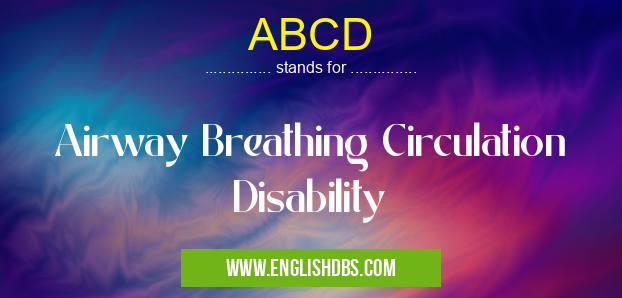What does ABCD mean in DISABILITY
ABCD stands for Airway Breathing Circulation Disability. It is a medical acronym that is used to assess the condition of a patient who has suffered trauma or illness. It is used by healthcare professionals to quickly assess the patient’s condition and determine what treatment is necessary. The ABCD assessment allows healthcare professionals to prioritize care and provide more immediate life-saving interventions in an emergency situation.

ABCD meaning in Disability in Medical
ABCD mostly used in an acronym Disability in Category Medical that means Airway Breathing Circulation Disability
Shorthand: ABCD,
Full Form: Airway Breathing Circulation Disability
For more information of "Airway Breathing Circulation Disability", see the section below.
» Medical » Disability
Airway
The airway is assessed to check if there are any blockages that may be preventing the patient from breathing properly. This can include obstruction of the nose, mouth, or throat. Healthcare professionals will check for any foreign objects that may be blocking the airway and remove them as needed. If there are concerns for any spinal cord injury, intubation may be required as well.
Breathing
The second area of assessment looks at how well the patient is breathing. During this assessment, healthcare providers will observe the rate and depth of breaths taken by the patient as well as any signs of distress such as wheezing or cyanosis (blueness around the mouth). A pulse oximeter (a device used to measure oxygen saturation) may also be placed on the patient’s finger or earlobe to help monitor their oxygen saturation level. Oxygen therapy may need to be administered if there are signs of impaired breathing or low oxygen saturation levels present.
Circulation
In assessing circulation, healthcare providers will check for evidence of pale skin (indicating poor circulation) and whether a radial pulse (in wrists) can be felt easily or not at all (which could indicate shock). Blood pressure and heart rate will also need to be measured using appropriate equipment such as a stethoscope and sphygmomanometer (blood pressure cuff). Any irregularities in these readings should result in further investigation into cardiac functioning and possible treatments being administered accordingly .
Disability
The disability portion of an ABCD assessment looks at any neurological/cognitive impairments that a person might have suffered due to their trauma or illness. This involves evaluating factors such as mental status, speech/language abilities, motor skills, sensory function, balance/coordination, reflexes and memory functions.
Essential Questions and Answers on Airway Breathing Circulation Disability in "MEDICAL»DISABILITY"
What is ABCD?
ABCD stands for Airway Breathing Circulation Disability. It is a vital medical assessment tool used to quickly assess a patient's condition in emergency situations. The term “ABCD” refers to the four core factors of emergency medical care: airway, breathing, circulation, and disability.
What order should I follow when assessing an ABCD patient?
When assessing ABCD patients, it is important to consider these four core elements in the following order of importance : airway, breathing, circulation, and disability. This allows for a quick and comprehensive assessment of the patient's immediate condition which can then be used to guide further medical intervention.
What are some examples of potential treatments for addressing issues related to ABCD?
Treatments can vary depending on the specific diagnosis and severity of symptoms; however, general interventions may involve establishing or maintaining an open airway, providing supplemental oxygen or ventilation support as needed, administering fluids or medications to maintain adequate circulation or compensate for any blood loss, and providing support for any physical disabilities that may affect the patient’s overall prognosis.
How does a doctor assess an airway issue?
In assessing an airway issue related to ABCD, a doctor will typically examine whether the patient’s airways are obstructed or blocked by foreign objects or substances. They will also evaluate whether there is an oral-airway obstruction caused by swelling of the tissue within the mouth and throat area.
How do doctors assess breathing issues?
When evaluating a patient’s respiratory status as part of an ABCD assessment, doctors generally look at objective measures such as respiratory rate and depth along with subjective clinical findings such as presence/absence of breath sounds when listening with a stethoscope. Oxygen saturation levels may also be monitored with pulse oximetry if available.
How do doctors assess circulation problems?
Doctors typically measure certain parameters like blood pressure and heart rate when evaluating circulatory status as part of an ABCD assessment. They may also use devices such as ultrasound machines to view internal organs or other diagnostic tools like ECGs (electrocardiograms) in order to identify any abnormal heart rhythms.
What types of assessments are included within disability evaluation under the ABCD system?
Disability evaluation under the ABCD system includes assessments regarding motor functions such as strength and coordination; sensory functions such as vision and hearing; level of consciousness; communication skills; cognitive abilities; personal activities such as dressing & bathing independently; risk factors related to falls or injury; mobility & transfer skills; speech & language skills; mental health status; social functioning ability & appropriateness; nutritional strategies & diets that are designed according to patient needs; coping abilities & stress responses relating to chronic conditions or treatments like chemotherapy & radiation therapy etc.
Can neurological deficits be evaluated using the ABCD system?
Yes – neurological deficits (brain injuries) can be evaluated using the ABCD system after careful neurological examination by trained professionals which enables them to establish diagnostic features which helps procedural decisions about treatment options available.
Final Words:
An ABCD assessment helps medical professionals quickly evaluate a sick or injured person’s condition so that they can prioritize treatments based on their needs in order to prevent further harm from occurring in an emergency situation. By providing life-saving interventions when needed an ABCD assessment ensures people receive optimal care even in times when time matters most.
ABCD also stands for: |
|
| All stands for ABCD |
